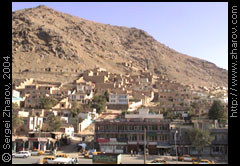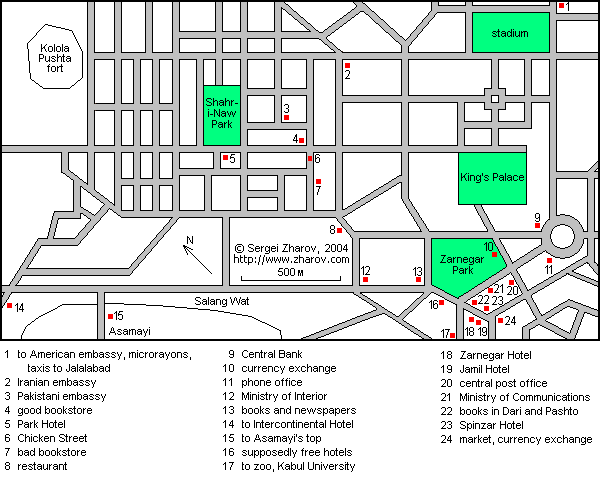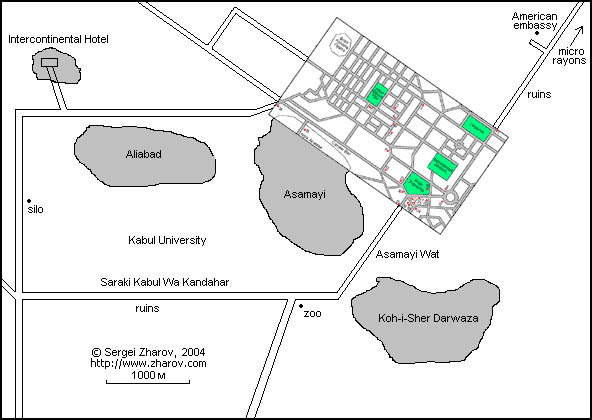Guidance: Kabul
Sightseeing
It is actually hard to point to any specific places of interest — Kabul is one big place of interest. You can plainly walk along the streets — that is interesting enough.
Accommodations
Wherever your intercity taxi drops you off, take a local one and ask to bring you to Spinzar Hotel. That is exactly the place where you will not stay, but its location is well-known to all taxi drivers, and the recommended hotels are just across the street from it. From any Kabul bus station you should pay about a dollar to get there.
Alternatively, you can walk there on foot if you are coming from Jalalabad. That bus station is about 2 km from the target. The only tall building in Kabul, the Ministry of Communications, is visible from there. Walk towards it and leave it on your left. The very first street intersection after that is where you turn left. About 40 meters past that you will see the two recommended hotels on the right side of the road, and Spinzar will be on the left side.

|
| Ali Abad mountain in Kabul |
These recommended hotels are Jamil and Zarnegar. Both have small signs in English, so it is relatively easy to find them. A room in each one costs about 10 dollars. As usual, the locals pay five dollars there, but you will be asked for 20 to start with.
Jamil is slightly better because it has private bathrooms in the rooms. There is no running water, but each bathroom has a 200-liter drum, which is filled up by the staff daily. You can wash up and flush the toilet, therefore. The building itself has more space, too. The staff speak English. The only disadvantage is the absence of a restaurant, but there is one in the neighboring Zarnegar.
Because Jamil is better, it is often full, and then your alternative is Zarnegar. The manager speaks French but no English. After entering the internal yard, go upstairs to the second floor. There will be a restaurant on the right and the reception on the left. Communal bathrooms are always occupied and not very clean. There are two water drums in each one, but they get empty early in the morning because the whole floor uses them.
Zarnegar's advantage is its restaurant and huge windows in the rooms. Some of them face that tall building, and all of them provide interesting views.
When negotiating the price, threaten to go to the other hotel — they are direct competitors.
Coming back to the intersection and going further in this direction along Salang Wat, you will supposedly discover some cheap or even free hotels, but I have not seen any.
The already mentioned Spinzar does not go lower than 20 dollars, and for this money you get a room with no bathroom, so it does not make sense to stay here. Park Hotel at the intersection charges too much for too little.
On the western side of Shahr-i-Naw park there is another Park Hotel that charges about 25 dollars. The location is definitely more convenient, but it is too expensive.
Intercontinental Hotel is a foreign morons' demoneying center. Prices start at 70 dollars for a single room. They have everything there: electricity, running water, hot water, one hour of free internet access per day, a good restaurant, a bookstore, a souvenir shop, a fur shop, a leather shop, money exchange, and tons of both Afghan and foreign scumbags.
Internet access, a great view from the hill for taking pictures, some hard to find postcards, and celebrating your arrival at the restaurant — these are the four legitimate reasons for a decent person to come here. If you do, do not hire a taxi at the hotel on the way back — they, naturally, will cheat you. Go down the hill to the main street and get a normal taxi there. It is a dollar from here to Spinzar.
Mustafa Hotel somewhere on Chicken/Flower Street gets consistently mentioned recently by travelers with money to throw out. It is too expensive and UN/NGO-infested. There is internet access, though, at four dollars per hour.
You can eat either in Zarnegar or in a few restaurants on the way to Chicken Street from there. A dinner in Intercontinental will cost you about five dollars, but their menu is not limited to pilau and kebab. You should visit them at least once.
City
Coming to the intersection near Zarnegar Hotel, you see Zarnegar Park. Walk around it, leaving it on your left. The Ministry of Communications will be on your right. The post office and the phone center are behind the ministry. You can call home and buy stamps there.

Soldiers check your things before you enter the post office. If they politely ask for a dollar, you should politely refuse. The stamps are sold at the counter on the opposite to the entrance wall. A permanently frightened woman servicing the counter does not speak English but really likes to steal money. One of her colleagues, though, speaks English and can help you if you really need it. Or you can simply show a postcard to the thieving woman and point to the corner where stamps usually are. Or you can ask for tickiti posta, stamps. Count your change!
To place an international phone call, inquire at a counter to the left of the entrance.
If instead of going to the post office you turn left at the crossing, you will find currency exchange people at the park fence. Ask a few of them for the exchange rate and bargain a little. Follow that segment of the fence and the next one, and you will end up on a street parallel to Chicken Street, one block away from it. This is where Shahr-i-Naw — the area with embassies and various stores — starts.
If instead of turning left or right you go straight forward at the crossing, you will get to Pushtunistan Square with one more phone center but with shorter lines. The central bank of Afghanistan, Da Afghanistan Bank, is also here, but its usefulness for you is limited.
From Pushtunistan Square you can walk up north for another 2 km until you get to the so-called microrayons, passing a few totally destroyed blocks where the Taliban defended the city, a stadium where they executed convicted criminals, and the American embassy. There is not much to do in microrayons, but Soviet buildings look strange in an Afghan city, especially when covered by bullet marks, so you can take a few pictures here.
Now coming back to the crossing at Zarnegar Hotel. It has a couple of bookshops, but it is not likely you will find there something in a language you understand. The street that goes from here to the northwest is Salang Wat. It does not have anything interesting, but at the very beginning of it, at the intersection, you will find an ice-cream shop on the left side and bookstalls with a few English-language books and even newspapers on the right. The ice-cream shop is where the free hotels are supposed to be, but no hotels of any kind have been discovered in this area at all.
A little bit further along Salang Wat, and you will see the Ministry of Interior and the passport office. Somewhere here you can extend your visa, and it is advisable to take a translator with you for that.
It is probably pointless to walk further down this street. Intercontinental Hotel will be there eventually, but it is better to take a taxi to it for about a dollar from Zarnegar. Actually, there is one interesting place remaining in this direction: the side road that goes up the Asamayi mountain to the TV tower. The view of the city should be great from there. You should probably drop by a police station first and explain why you want to go up there since tourists do not usually do that and the guards at the tower can be confused by your arrival.

And again let us start at the intersection at Zarnegar. Exiting it in the southwestern direction along Asamayi Wat you will not see much at first — fruit stalls, mostly. At the nearest square this street will slightly turn right and become Jadai Sehi Akrab, also known as Jadi Mir Wais, also know as Sher-Shar Mina, also known as Saraki Kabul Wa Kandahar — the exact name depends on the year your map has been printed in. Kabul Zoo will be on the left. It is open and exhibits a real pig — wow.
On the left side of the multi-named street there will be destroyed blocks which are quite photogenic. I can only say it for the hundredth time: do not wander where people do not walk. These blocks have been destroyed not by the telekinetic powers, and you can easily step onto something quite material. Take pictures from the sidewalk.
Kabul University is on the right.
After a long walk you get to a square. Turn right. There is nothing interesting on the next 1.5-km section except the ruins and the silo where someone obviously was not going to give up. The silo is worth coming here.
At the end of that section you turn right once more and see Intercontinental Hotel. Now you know where you are — take a taxi to your hotel for a dollar.
Coming back to Chicken Street. After it joins the central street of Shahr-i-Naw, it becomes Flower Street. These two are often jointly called Chicken Street. Where Flower Street begins, there are two bookstores. The one that is closer to the intersection is better. It has lots of Afghan postcards. You can also buy some English-language books on Afghanistan. You can bargain here, but prices are fair enough.
Continuing north along Flower Street, you will find a few grocery stores with field rations and various imported stuff. A few souvenir shops are also here.
Continuing south along Chicken Street, you will mostly find souvenir shops. They are for foreign morons — either do not buy anything here or drop the price at least fivefold. There is one bookstore here, but they cheat there too, so do not buy anything except maybe postcards. Closer to the southern end, on the right side when walking south, there is a relatively big CD store and a small CD hole in the wall. Ahmad Zahir — you want to buy his compacts here. A dollar or less.
Shahr-i-Now itself is a commercial and government area with various embssies, including the Iranian and Pakistani ones, the king's palace — no admittance, — and Kolola Pushta Fort in the end of it.
In general, you can interestingly spend a lot of time in Kabul, especially if you need to get some visas. If you have no time, two–three full days will be enough to explore the major areas of the city.
Transportation
There are a few bus stations in the city, and you should find out in advance which one do you need. Taxis depart to Jalalabad from microrayons. To Kandahar — from near the silo. To Mazar-i-Sharif — a few kilometers along Salang Wat, and a local taxi from Zarnegar to there will cost about two dollars early in the morning.
The road to Mazar-i-Sharif is the best in the country. It takes about seven hours and 11 dollars. Lots of dead armor on the roadside. Many bridges have been destroyed, but the riverbeds are dry. The road passes through Salang Pass. Soviet engineers have built a 2700-meter-long tunnel there in the 1970th. Massoud has blown both its ends up to prevent the Taliban from using it. It is restored now, but you can still see the holes at the entrances. A taxi usually stops after passing through the tunnel. It is slightly cold there even in summer, but you will not freeze in a t-shirt in those few minutes you stay there. Strange roof-like constructions along the road have been built to protect it from snow.
To Kandahar it is 11 hours and 13 dollars. The road is good the first three hours to Ghazni and is destroyed after that. Taxis stop for lunch at a very expensive restaurant, two–three dollars per meal.
To Bamiyan it is seven hours and 11 dollars.
next: Mazar-i-Sharif and Balkh
more: Other things
this page: http://www.zharov.com/afghan/kabul.html
copyright: © Sergei Zharov, text, photos, maps, design, code, 2004–2024
feedback: sergei@zharov.com

